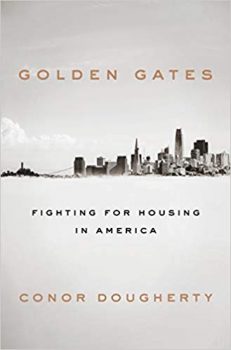
Walk around almost any big American city long enough and you run the risk of tripping over some homeless person sprawled on the sidewalk. The problem has been half a century in the making, but it’s gotten far, far worse during the past decade. And nowhere is it more severe than in California’s metropolitan cities of Los Angeles and San Francisco. Here — I’m writing from Berkeley, across the Bay from San Francisco — you’re likely to hear any one of a number of explanations for how things have gotten so bad. But if you want to know how to sort through the myths and misconceptions about housing and homelessness in America, a great place to start is Conor Dougherty’s outstanding new book, Golden Gates.
Estimated reading time: 6 minutes
Dougherty’s book is no dry academic treatise. It’s a lively account focusing on individual people (mostly in the San Francisco Bay Area) who are playing key roles in addressing the challenge of homelessness. If you live in this area, you may be familiar with some of the people Dougherty highlights:
Golden Gates: Fighting for Housing in America by Conor Dougherty (2020) 388 pages ★★★★★
- You’ll meet Harvard economist Ed Glaeser, housing developers Rick Holliday and Dennis O’Brien, and Scott Wiener, the six-foot-seven California State Senator from San Francisco who has become the point person for housing reform legislation in Sacramento.
- Dougherty also introduces teenage tenant Stephanie Hernandez and her mom Sandy whose fight to defend their apartment in the face of a 45% rent increase illustrates one of the central realities of the housing shortage.
- You’ll also meet housing activists Laura Foote Clarke and Sonja Trauss, who ran unsuccessfully for the San Francisco Board of Supervisors. Both are leaders in the emerging YIMBY (“Yes-in-my-backyard”) movement that seeks to counteract the knee-jerk NIMBYism that has squelched so many plans for housing development.
- And you’ll meet Damien Goodmon, who has parlayed tens of millions of dollars from the AIDS Healthcare Foundation in Loss Angeles in support of a statewide rent control measure.
- Steve Falk, the former city manager of Lafayette, California, enters the picture, too; he capped a long, successful career there by resigning in the face of intense opposition from the people of the town when he endorsed a measure to build new apartments. (Lafayette is a wealthy suburban town in which almost everyone lives in a single-family home.) There are even two of my own elected officials, Assemblymember Buffy Wicks and Lori Droste, who represents my neighborhood on the Berkeley City Council.
- Oh, and of course Jerry Brown figures into the story in big ways, too. He served as Governor of California during both periods when our housing shortage was so severe (1975-83 and 2011-19).
Misguided government policy lies at the root of homelessness in America
As Dougherty weaves together the stories of this disparate cast of characters, he gradually unravels the checkered history of government intervention in the American housing market. It quickly becomes clear that the roots of the homelessness that plagues our communities today lie in misguided and discriminatory policy of governments at all levels.
Today’s homelessness is, in large part, a manifestation of the institutional racism that drove the GI Bill and the FHA as well as the housing segregation that has long reflected practices in the real estate industry. (For example, “you could not get an FHA-backed loan in mixed-race neighborhoods.”) The economic inequality fostered by tax policy that rewards the rich and punishes the poor is a major factor, too. The domination of the automobile industry and heavy government investment in road building that led to the growth of the suburbs was another root cause in that it produced what Dougherty calls “government-sanctioned apartheid.” And local control of zoning that favors single-family homes prevents the development of new housing that might ameliorate the problem is a major factor as well. (Sadly, “it was Berkeley, in 1916, that wrote what was probably the nation’s first ordinance creating neighborhoods with single-family houses only.”)
Homelessness in America reflects a lack of affordable housing
Other factors as well enter into the picture. And homelessness itself is only the most visible aspect of the housing crisis that grips America today. “In the United States,” Dougherty writes, “the homeownership rate for young adults is at a multi-decade low, and about a quarter of tenant households spend more than half their income on rent. . . America’s largest metro areas [where multitudes flock in search of good jobs] now had about thirty-seven affordable homes and apartments for every hundred very-low-income renter households.”
Without fundamental change, government efforts to end homelessness in America will fall flat
In the absence of a massive redistribution of wealth and income that would even slightly flatten the inequality that characterizes America’s economy, government may find it virtually impossible to solve this problem. Consider this, for example: “California needed to build 3.5 million homes to even think about solving its housing crisis, and statewide it cost about $425,000 per unit — roughly double the median home price in the nation — to build a 100-unit affordable housing project.”
Dougherty doesn’t do the math, but I will: 3.5 million times $425,000 equals approximately $1.5 TRILLION. Even the billions that California state government is now devoting to the problem amount to a drop in the bucket — about 0.8 percent of what’s needed. Given the economic system in which we live, only the private sector can eliminate the housing shortage. But they’ll first need a much broader population base that can afford to buy the homes they build.
Signs of hope are starting to appear
Are there signs of hope? Of course. Here in California, our state government and many municipalities from Los Angeles to Berkeley are waking up and taking action. The city of Minneapolis has abolished single-family zoning, and Scott Wiener is introducing a bill in the California State Senate that would strictly limit single-family zoning statewide. However, as Dougherty makes clear, “There’s no way to rectify a housing shortage other than to build housing, and there’s no way to take care of people whom the private market won’t take care of other than subsidies or rent control, or both.” And despite its tendency to suppress housing construction, rent control is expanding — statewide in Oregon, broadened in New York, and freshly adopted in other communities around the nation. Massive construction of subsidized and affordable housing would be far preferable, but people come first.
About the author
Bay Area native and Oakland resident Conor Dougherty has covered economics and real estate on the West Coast for both the New York Times and the Wall Street Journal. Golden Gates is his first book.
For related reading
This is one of the Good books about economic inequality reviewed here.
For another enlightening book about housing in America, see my review of Evicted: Poverty and Profit in the American City by Matthew Desmond, at Does the profit motive cause homelessness?
You might also be interested in:
- Top 10 nonfiction books about politics
- My 10 favorite books about business history
- 20 top nonfiction books about history
- 10 enlightening books about poverty in America
And you can always find my most popular reviews, and the most recent ones, on the Home Page.


























